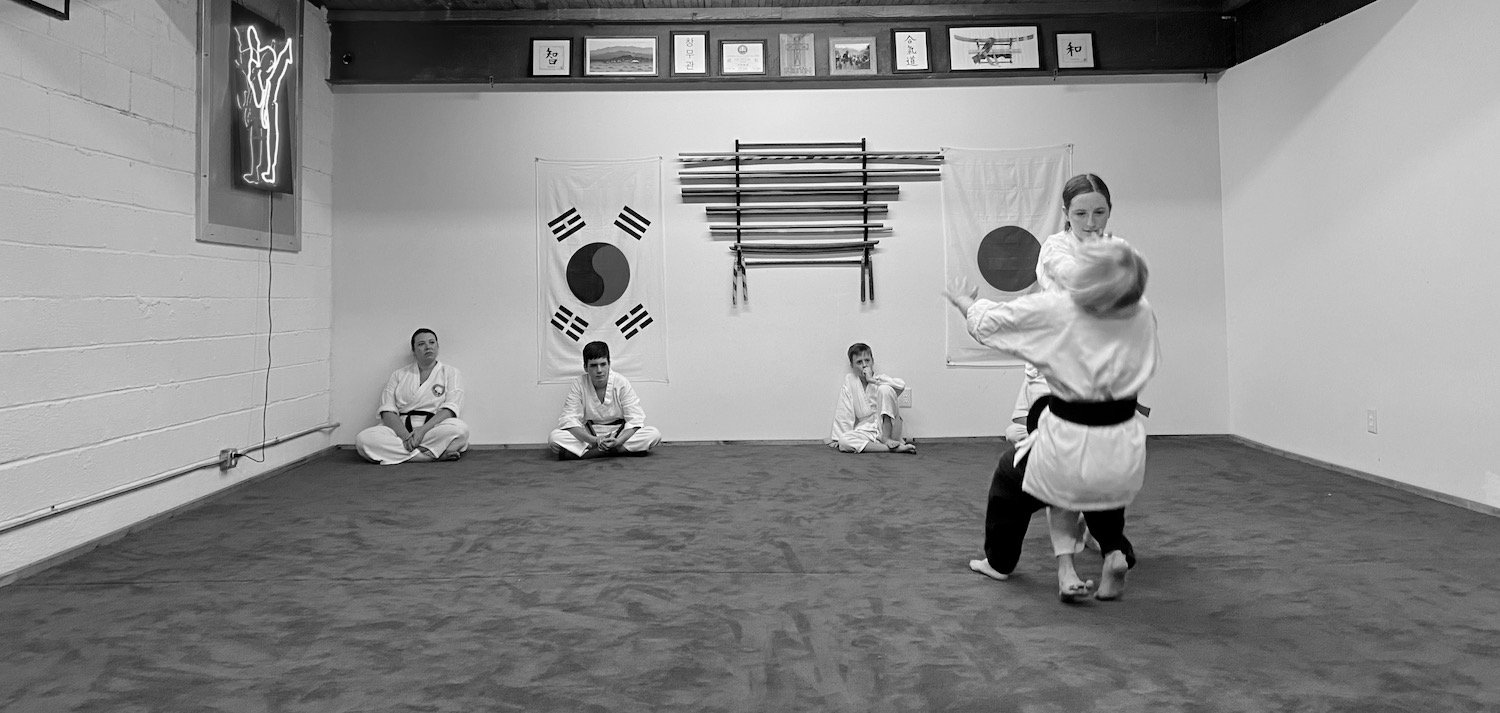junior rank criteria
For children and students with certain physical limitations, we utilize a junior ranking system up to the rank of Chil-geup (green belt).
7 areas of student assessment
Kihon
Kata
Ippon Kumite
Weapons
Fighting
Academics
Teaching
sip-geup duljae, advanced white belt
Ukemi (breakfalls), Unsoku
N/A
N/A
Knife Drills
Block & Catch
N/A
gu-geup, orange belt
Ukemi (front rolls), Unsoku
Ki-Bone IL
N/A
Knife Attacks
Taking Balance, Irimi & Tenkan
N/A
gu-geup duljae, advanced orange belt
Fighting Techniques 1-2
Ki-bone E
N/A
Knife Blocking (corners)
Randori (1-on-1)
Core Principles of Spirit 1-3, Itosu’s Ten Precepts of Karate
N/A
pal-geup, yellow belt
Tandoku-undo
Review
Punches (5)
Knife Blocking (Stabs)
Randori (1-on-1), Kumite (1-on-1)
N/A
pal-geup duljae, advanced yellow belt
Fighting Techniques 3
Aikido Hand Grabs
Punches, Grabs (7)
Review
Review
N/A
pal-geup setjae, purple belt
Fighting Techniques 4
Ki-bone Som
Punches, Grabs (9)
Review
Blind Randori (1-on-1), Kumite (1-on-1)
Core Principles of Spirit 9-10, Bunkai Disassembly of Early Chang Moo Kwan Forms
N/A
pal-geup netjae, advanced purple belt
Fighting Techniques 5
Uke for Aikido 15 Basics
Punches, Grabs (10)
Knife Slashes
Review
N/A
chil-geup hujin, junior green belt
Review
Review
Punches, Grabs (15)
Bokken Kata Ni
Review
N/A
chil-geup, green belt
Review
Review
Punches, Grabs (20)
Review
Randori (2-on-1)
Class Stretches & Warmups
At this point, the junior ranking system ends and continues with the standards set by the normal class ranking system for the rank of Yuk-geup (advanced green belt) and beyond. As the rank of Shodan (black belt) cannot be awarded to children, Yeong-geup, or Senior Brown Belt, is a transitional rank adopted by Catawba Valley Martial Arts in order to accommodate students below the age of eighteen (18) who have met the requirements for the rank of Shodan (i.e. black belt). Catawba Valley Martial Arts considers a Black Belt to be more than just an expert performer of Cheonjikido technique. Rather, we hope that such will prove able instructors of what they have learned, as well as good citizens with virtuous moral character and emotional maturity. Cheonjikido needs confident, yet humble yudansha (i.e. black belts) who will represent the style well as both members and instructors. That being said, WE DO NOT BELIEVE THAT CHARACTER DEVELOPMENT IS FULLY ACQUIRED AND CAPABLE OF BEING PROPERLY ASSESSED IN AN INDIVIDUAL BELOW THE AGE OF EIGHTEEN. This age, therefore, is considered to be the earliest point of determining whether a student can responsibly represent Catawba Valley Martial Arts and/or the style of Cheonjikido within the community as a Black Belt. The Yeong-geup rank will be implemented in the following fashion:
yeong-geup, senior brown belt
A brown belt student below the age of eighteen (18), who has been deemed ready for promotion by his instructor, will undergo the normal promotion procedure for the rank of Shodan (black belt), complete in every respect.
If criterion for a black belt is met, the student below the age of eighteen (18) will be awarded the senior brown belt rank.
This rank will be signified by a black strip worn on the brown belt.
The promotion fee will be one-half of the amount designated for black belt; the other half is payable when and if the senior brown belt is awarded the full rank of black belt.
A senior brown belt will rank between brown and black belts in class formation.
Senior brown belts may attend yudansha meetings but WILL NOT retain voting privileges.
Upon reaching the age of eighteen (18), a senior brown belt is eligible to be recommended by his instructor for the rank of Shodan (black belt). THIS WILL BE BY INVITATION AND IS NOT AUTOMATIC.
An actual re-testing in terms of a senior brown belt being awarded a black belt is up to the discretion of the yudansha.
This rank is never to be awarded for an inferior performance by a student testing for black belt. The promotee is to be a qualified black belt in every respect except age.
Exceptions to this age limitation or the implementation of the yeong-geup rank are on a case-by-case basis and us ultimately left to the discretion of the yudansha.











